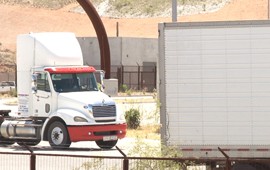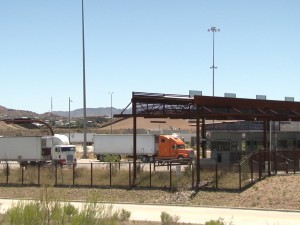- Slug: BIZ-Nogales Port, 900 words
- Photos available (thumbnails, captions below)
- Video: https://www.youtube.com/watch?v=vLdFbEMLbqU
By WILL SOWARDS
Cronkite News
NOGALES – Engines roar and the smell of diesel wafts through the air as trucks steadily pass through the final checkpoints as they enter Arizona from Mexico.
About 300,000 commercial vehicles pass through the Mariposa Port of Entry every year on their way into the United States, and it’s one of the busiest ports on the border.
The federal government spent nearly $200 million to add booths and inspection dock spaces to help increase traffic between the U.S. and Mexico and cut wait times. Trucks began using the new lanes in October 2014.
So far, it appears to be working.
“Definitely the widening of the border has been good for us,” said Octavio Vasquez, a facility manager for the Nogales branch of ProTrans, an Indiana-based logistics company. “We have seen an extra amount of flow of trailers, and they are coming in faster.”
Since the four-year renovation ended, port traffic has increased nearly 7 percent and wait times have decreased as well, according to U.S. Customs and Border Protection statistics.
“I have noticed a change,” said Juan Egera, a warehouse worker at the Mariposa Port of Entry. “There’s more traffic and more space for the trucks that are being looked over. Since the renovations, everything has been faster.”
But, there is some debate about how effective the renovation has been. A combination of stricter regulation and lack of infrastructure has lead some to believe that Arizona is lagging behind other border states.
Though the Mariposa Port of Entry processes hundreds of thousand of trucks each year, it pales in comparison to some ports located in California and Texas – states that have benefited, some say, from more lax regulation and better highways.
Border barriers
The port serves as the busiest land port in Arizona for privately owned vehicles, according to the U.S. General Services Administration. In addition, more than 3 million pedestrians cross the border at the Nogales port every year.
All that activity is important, officials said. Every day, Mexican visitors to Arizona spend more than $7 million in hotels, malls, restaurants and other businesses, according to a 2008 study from the University of Arizona.
But, the commercial traffic is critical to the region and beyond. According to the Arizona-Mexico Commission, Arizona brings in $16 billion from trade with its southern neighbor, about 38 percent of U.S.-Mexico trade.
The port is the main entry point for fresh produce entering from Mexico for the West Coast, according to the U.S. General Services Administration.
And although the federal government may have improved the port, some elected officials have turned their attention to the regulations for commercial trucks.
“The state of Arizona has a different relationship with the federal Department of Transportation than other states,” said Lance Jungmeyer with the Fresh Produce Association of the Americas, an organization that focuses on U.S.-Mexico agricultural trade. “Some time ago, Arizona made an agreement to allow for stricter inspections by the federal government, but Texas and California did not.”
He said these stricter inspections increase wait times and create a trade barrier for truckers trying to enter Arizona.
On April 16, 10 of Arizona’s 11-person federal delegation signed a letter to the director of the Federal Motor Carrier and Safety Administration asking for a reversal of these restrictions.
“It is our understanding that both Mexican and U.S. carriers have deemed Arizona ports of entry to be more difficult to cross than those of other border states because of the frequency of inspections and out-of-service orders issued by (the administration),” the letter said.
It went on to request a change to bring the Arizona in line with other border states.
Jungmeyer said it’s a major issue that’s holding Arizona back from being one of the top states for imports from Mexico.
Truckers fear citations for small infractions.
In some cases, a quick run across the border only nets a trucker about $50, but fines can cost more than $3,000 for some minor mistakes, like incomplete paperwork.
“There are efforts right now to reverse (the inspections),” Jungmeyer said. “A huge factor, is that federal elected officials are coming to the rescue on this. We’ve put in a huge investment and a huge infrastructure (in Nogales), but if the federal government is applying a heavy hand there, then why wouldn’t a trucker go somewhere else?”
Road to the future
For many truckers, passing through the border will likely be the easiest part. Vasquez said officials need to improve infrastructure on both sides of the border.
On the Mexican side, lack of maintenance causes problems. In Nogales, there’s a bigger issue, he said.
Only one road connects the Mariposa Port of Entry with Interstate 19, the major highway most truckers or distributors use to transport product to other U.S. cities. Vasquez said accidents happen regularly along this four-mile stretch, usually between semitrailers and other motorists.
“We only have one road, it’s like a bottleneck,” Vasquez said. “Of course, there are going to be some safety issues and some traffic issues. Many citizens crossing in their own cars have to deal with this traffic.”
While there have been studies conducted on building a second road or a direct connection with I-19, no official plans have been made. Until then, many truckers and motorist will have to deal with what Vasquez sarcastically calls “afternoon fun.”
“Try to get to the freeway at 4:30 in the afternoon using this only entry to the freeway,” he said. “Have fun.”
^___=

Though the Mariposa Port of Entry processes hundreds of thousand of trucks each year, it pales in comparison to some ports located in California and Texas. (Cronkite News photo by Maria Hill)
^___=
About 300,000 commercial vehicles pass through the Mariposa Port of Entry every year on their way into the United States, and it’s one of the busiest ports on the border. (Cronkite News photo by Maria Hill)
